“Many birds sun themselves. The most enthusiastic of sunbathers appear to be various species of doves, especially Zebra Doves (Geopelia striata) and Spotted Doves (Streptopelia chinensis). Both are frequent visitors to my garden, but Spotted Dove, being much larger, and somewhat aggressive (whoever said that doves were peaceful?) hog all the prime sunbathing spots.
“Like mad dogs and Englishmen, they bake on my pathway in the noonday sun. Believe you me, the cement is HOT. Sometimes, when in a hurry to collect the mail, I don’t bother to put on slippers, and have to RUN to the front gate and back to avoid getting blisters on my feet.
“But the Spotted Doves appear to have thicker skins. They can cook for half an hour at a time, going, I am sure, from rare, half-baked to well-done, before they finally take their leave.
“They are diligent in getting heated up. They carefully expose themselves, part by part, and turn to catch the most sunlight. Note the position of the shadows in the photos. You can see clearly that the dove with raised wing is doing its best to catch the maximum amount of sunlight on the underside.
“Sometimes, space is short on the pathway.
“Well, doves that do not like crowds make do and sunbathe anywhere they can.
“Visitors to this website have commented that quite a number of species of birds sunbathe, possibly to rid themselves of parasites. It is a known fact that certain fleas are sensitive to heat, and cannot survive high temperatures.
“Of course, some birds stand in the sun simply to dry out.
“Chief among them would be the free-loading kingfisher who comes daily to help himself to the Platies (Poecilia maculatus) that breed in my water lily pond. Thankfully, Platies are prolific.
“He takes his time to groom himself, and sometimes to have a good stretch, before flying off.
“Other creatures that sunbathe do so to reach operating temperature. Reptiles are ectothermic, and can be sluggish when their body temperatures are low. To get ready for action, lizards warm up in the sun, like this Calotes versicolor – a foreign talent from Thailand that has made Singapore its home.
“Once fully warmed up, such Agamid lizards, including our own native Calotes cristatellus, (which is now unfortunately very rare) are tremendously agile and extremely swift.
“Larger lizards, with larger body masses, take longer to warm up. A certain Monitor Lizard (Varanus salvator) has found a way to shorten the process. Not only does it sunbathe, but it chooses to do so right beside the airconditioning compressor of my home.
“It often positions itself on a masonry wall erected to protect my plants from the blast of hot air from the airconditioner. There, it quickly warms up, before proceeding on its daily patrol.
“Monitors are active by day, cover great distances in search of food, and eat voraciously to obtain the energy that they require to move their bulk around. Plus, they supplement their intake with solar power.”
Lee Chiu San
Singapore
5th June 2014


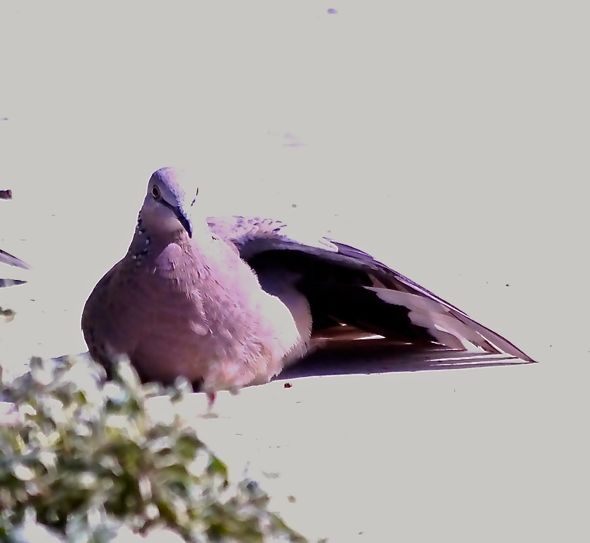
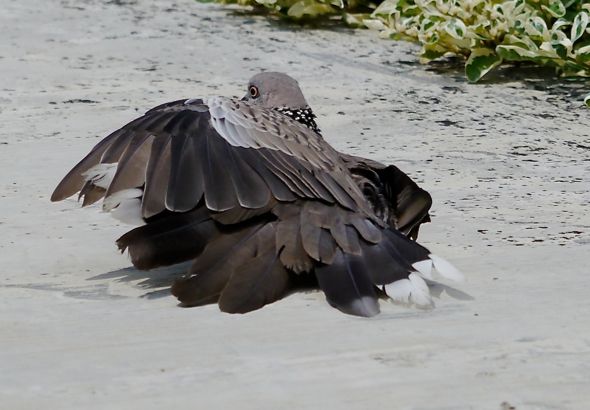
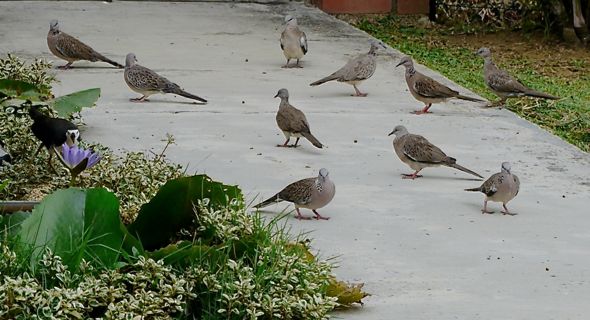

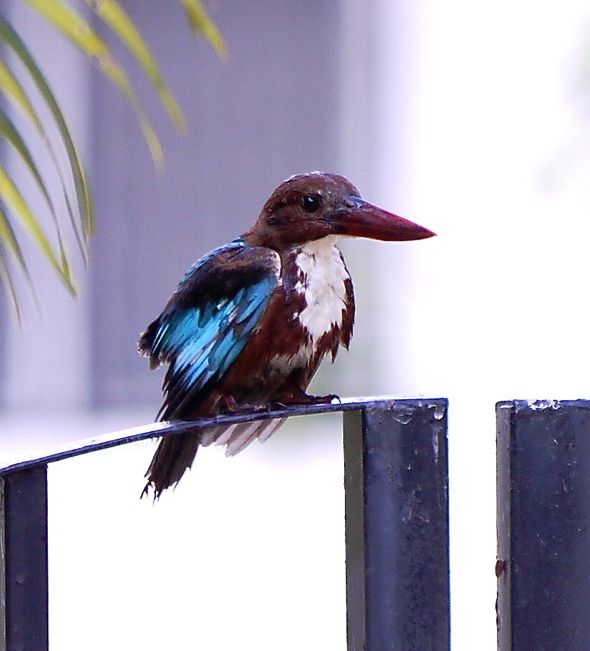
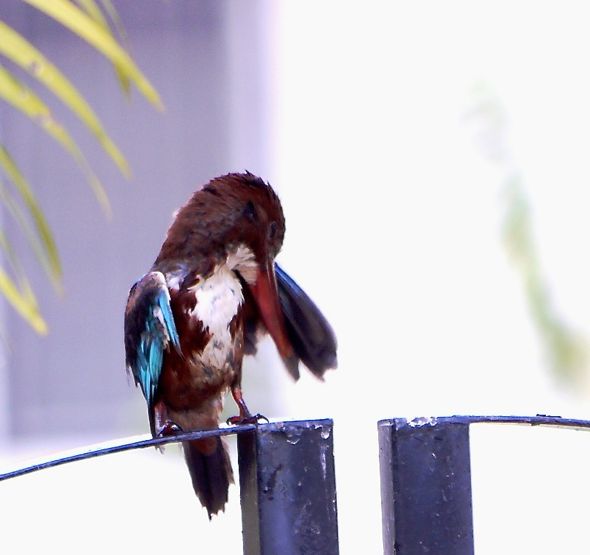
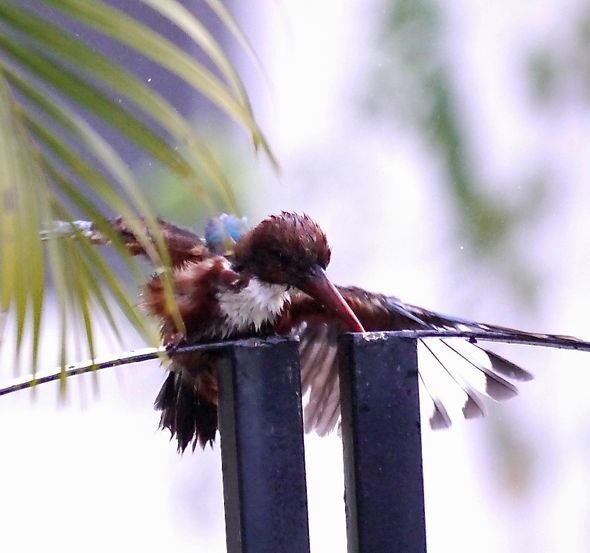

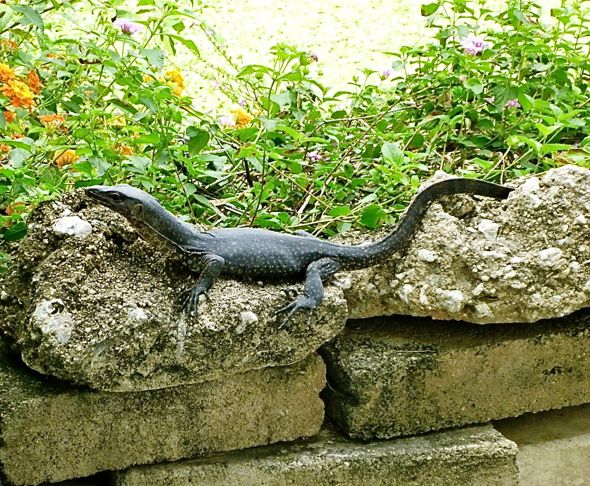







2 Responses
Dear Lee,
Your house certainly is a popular leisure playground for a varity of birds, especially the spotted doves.
How did you manage to get them into your garden? Did you feed them with something?
Thanks and regards,
Jack Leong.
If you want to attract birds to your garden, make sure that the environment can support the bird population. In other words, your home must be a place where birds can find a decent living.
I am not about to go into the legalities of whether or not feeding birds within your own house will get you into trouble with the authorities in Singapore, but in Europe and America, many bird watchers do feed.
If you are not in Singapore, and you decide to feed, make sure that you do it regularly and conscientiously. You cannot build up a population of birds to a heavy density in a neighbourhood, then go on a long vacation, and leave them to starve to death.
If you want them to spread out to fend for themselves, you will have to cut down the food rations gradually, not suddenly.
That said, in my house, a lot of natural food is provided for the birds. My lawn is mowed at slightly longer intervals than normal, allowing grass to produce some seeds.
In addition to the normal cow grass and carpet grasses, I sow a lot of white millet. This sprouts readily. The young shoots are eaten by doves, rails, waterhens and crakes.
Other permanent features that attract birds are my series of small ponds and the selective planting of bird-friendly trees.
There are more than 10 water containers dotted around my garden, of the sort which I have described in earlier articles on this website on how to attract kingfishers to a suburban garden, and how to build bird-friendly water features. Without the provision of additional feeding, these water containers generate sufficient baby fish, tadpoles, water snails and edible water weeds to attract kingfishers, white-breasted waterhens, little green herons and the occasional slaty-breasted rail or ruddy crake.
There is also plenty of planting of torch gingers, calatheas and heliconias to provide cover for these wading birds.
Within the water are plenty of Thallia (water Canna) which not only provide cover for the wading birds, but are also favourite nectar sources for sunbirds.
In the more open parts of the garden I plant a hedge of hibiscus for the sunbirds.
Next to my porch, and surrounding my garden pavilion are Murraya paniculata (orange jasmine) and Wrightia religiosa (water jasmine) bushes in pots. These provide scent and nectar for the sunbirds, and Yellow-vented Bulbuls eat the Murraya fruits.
People may consider Sendudok (Melastoma malabarthircum) or Straits Rhododendron to be a weed. I think that it has attractive flowers, and produces berries that bring lots of birds. There is a row of these plants in my back garden, and I fertilise and water them regularly to encourage fruiting.
By accident, Australian mulberry trees have sprouted in both my house and that of my neighbour, also a bird lover. When these fruit, birds come in droves, especially glossy starlings.
I am fortunate enough to have moved into a house with a mature Ficus benjamica in the garden. There is an even bigger one just across the road. Both these trees attract lots of birds, not only for the fruits on the trees, but for those fallen on the ground too. Spotted doves and zebra doves pick up the fallen fruit, and even Magpie Robins come around to hunt the insects which the fruits attract.
My bird-loving neighbour does not object to the koel, parakeets, orioles and many other birds that raid her rambutan and chiku trees. Though these trees are not in my garden proper, some of their branches overhang our fence, and I get to see all the avian visitors.